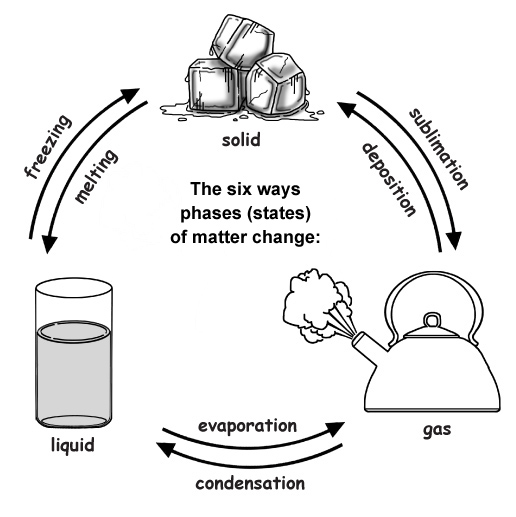

Physical Science For 5th Grade
LINKS to content and activities to help fulfill the Next Generation Science Standards shown below.
PS1.A: Structure and Properties of Matter
PS1.B: Chemical Reactions
Phases of Matter – Gas, Liquids, Solids
Next Generation of Science Standards (NGSS) - Grade 5
Disciplinary Core Ideas
PS1.A: Structure and Properties of Matter
Science and Engineering Practices (NGSS)
Developing and Using Models
Modeling in 3–5 builds on K–2 experiences and progresses to building and revising simple models and using models to represent events and design solutions.
• Use models to describe phenomena. (5-PS1-1)
Planning and Carrying Out Investigations
Planning and carrying out investigations to answer questions or test solutions to problems in 3–5 builds on K–2 experiences and progresses to include investigations that control variables and provide evidence to support explanations or design solutions.
• Conduct an investigation collaboratively to produce data to serve as the basis for evidence, using fair tests in which variables are controlled and the number of trials considered. (5-PS1-4)
• Make observations and measurements to produce data to serve as the basis for evidence for an explanation of a phenomenon. (5-PS1-3)
Using Mathematics and Computational Thinking
Mathematical and computational thinking in 3–5 builds on K–2 experiences and progresses to extending quantitative measurements to a variety of physical properties and using computation and mathematics to analyze data and compare alternative design solutions.
• Measure and graph quantities such as weight to address scientific and engineering questions and problems. (5-PS1-2)
Crosscutting Concepts
Cause and Effect
• Cause and effect relationships are routinely identified and used to explain change. (5-PS1-4)
Scale, Proportion, and Quantity
• Natural objects exist from the very small to the immensely large. (5-PS1-1)
• Standard units are used to measure and describe physical quantities such as weight, time, temperature, and volume. (5-PS1-2),(5-PS1-3)
Connections to Nature of Science
Scientific Knowledge Assumes an Order and Consistency in Natural Systems
• Science assumes consistent patterns in natural systems. (5-PS1-2))
Performance Expectations
Students who demonstrate understanding can:
5-PS1-1. Develop a model to describe that matter is made of particles too small to be seen. [Clarification Statement: Examples of evidence supporting a model could include adding air to expand a basketball, compressing air in a syringe, dissolving sugar in water, and evaporating salt water.] [Assessment Boundary: Assessment does not include the atomic-scale mechanism of evaporation and condensation or defining the unseen particles.]
5-PS1-2. Measure and graph quantities to provide evidence that regardless of the type of change that occurs when heating, cooling, or mixing substances, the total weight of matter is conserved. [Clarification Statement: Examples of reactions or changes could include phase changes, dissolving, and mixing that form new substances.] [Assessment Boundary: Assessment does not include distinguishing mass and weight.]
5-PS1-3. Make observations and measurements to identify materials based on their properties. [Clarification Statement: Examples of materials to be identified could include baking soda and other powders, metals, minerals, and liquids. Examples of properties could include color, hardness, reflectivity, electrical conductivity, thermal conductivity, response to magnetic forces, and solubility; density is not intended as an identifiable property.] [Assessment Boundary: Assessment does not include density or distinguishing mass and weight.]
5-PS1-4. Conduct an investigation to determine whether the mixing of two or more substances results in new substances.
Common Core State Standards Connections
ELA/Literacy
RI.5.7 Draw on information from multiple print or digital sources, demonstrating the ability to locate an answer to a question quickly or to solve a problem efficiently. (5-PS1-1)
W.5.7 Conduct short research projects that use several sources to build knowledge through investigation of different aspects of a topic. (5-PS1-2),(5-PS1-3),(5-PS1-4)
W.5.8 Recall relevant information from experiences or gather relevant information from print and digital sources; summarize or paraphrase information in notes and finished work, and provide a list of sources. (5-PS1-2),(5-PS1-3),(5-PS1-4)
W.5.9 Draw evidence from literary or informational texts to support analysis, reflection, and research. (5-PS1-2),(5-PS1-3),(5-PS1-4)
Mathematics
MP.2 Reason abstractly and quantitatively. (5-PS1-1),(5-PS1-2),(5-PS1-3)
MP.4 Model with mathematics. (5-PS1-1),(5-PS1-2),(5-PS1-3)
MP.5 Use appropriate tools strategically. (5-PS1-2),(5-PS1-3)
5.NBT.A.1 Explain patterns in the number of zeros of the product when multiplying a number by powers of 10, and explain patterns in the placement of the decimal point when a decimal is multiplied or divided by a power of 10. Use whole-number exponents to denote powers of 10. (5-PS1-1)
5.NF.B.7 Apply and extend previous understandings of division to divide unit fractions by whole numbers and whole numbers by unit fractions. (5-PS1-1)
5.MD.A.1 Convert among different-sized standard measurement units within a given measurement system (e.g., convert 5 cm to 0.05 m), and use these conversions in solving multi-step, real-world problems. (5-PS1-2)
5.MD.C.3 Recognize volume as an attribute of solid figures and understand concepts of volume measurement. (5-PS1-1)
5.MD.C.4 Measure volumes by counting unit cubes, using cubic cm, cubic in, cubic ft, and improvised units. (5-PS1-1)
When you research information you must cite the reference. Citing for websites is different from citing from books, magazines and periodicals. The style of citing shown here is from the MLA Style Citations (Modern Language Association).
When citing a WEBSITE the general format is as follows.
Author Last Name, First Name(s). "Title: Subtitle of Part of Web Page, if appropriate." Title: Subtitle: Section of Page if appropriate. Sponsoring/Publishing Agency, If Given. Additional significant descriptive information. Date of Electronic Publication or other Date, such as Last Updated. Day Month Year of access < URL >.
Amsel, Sheri. "Grade 5 - 5-PS1 Matter and Its Interactions" Exploring Nature Educational Resource ©2005-2024. December 13, 2024
< http://www.exploringnature.org/db/view/Grade-5-5-PS1-Matter-and-Its-Interactions >


